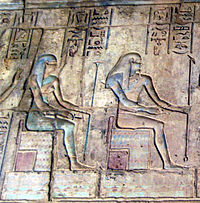Kek (mitologija)
| Kek v hieroglifih | ||||||||||
|---|---|---|---|---|---|---|---|---|---|---|
Kek | ||||||||||
Kekui | ||||||||||
Kekuit | ||||||||||

| ||||||||||
Kek je bil poosebljenje prvobitne teme (egipčansko kkw sm3w[1]) v staroegipčanski hermopolski ogdoadski teoriji o nastanku sveta. Ogdoado so sestavljali štirje pari božanstev, štirje moški bogovi v paru z njihovimi ženskimi dvojniki. Kekova dvojnica je bila boginja Kekuit.[2][3][4] Kek in Kekuit sta v nekaterih pogledih predstavljala noč in dan in sta se zato imenovala tudi "dvigalec dneva" in "dvigalka noči".[5]
Imeni Keka in Kekuit sta se pisali kk ali kkwy. H Kekovemu imenu se je pripisoval hieroglif za sonce, k Kekuitinemu pa hieroglif za temo.[6]
Zgodovina
[uredi | uredi kodo]Na najstarejših upodobitvah je imel Kek kačjo glavo, Kekuit pa žabjo ali mačjo glavo. Na nekaterih upodobitvah sta se enačila s Ka in Kait. V teh primerih je imel Ka-Kek glavo žabe, na kateri je čepel hrošč, Kait-Kekuit pa glavo kače, na kateri je slonel sončni disk.[7]
V grško-rimskem obdobju Egipta se je Keka upodabljalo kot moškega z žabjo glavo, Kekuit pa kot žensko s kačjo glavo, tako kot vse druge dualistične koncepte ogdoade.
Sklici
[uredi | uredi kodo]- ↑ E. Hornung. "Licht und Finsternis in der Vorstellungswelt Altägyptens". Studium Generale 8 (1965): 72-83.
- ↑ Budge, E.A. Wallis (1904). The Gods of the Egyptians: Or, Studies in Egyptian Mythology. 1. Methuen & Co. str. 241, 283–286.
- ↑ Budge, E. A. Wallis (1904). The Gods of the Egyptians: Or, Studies in Egyptian Mythology. 2. Methuen & Co. str. 2, 378.
- ↑ Steindorff, Georg (1905). The Religion of the Ancient Egyptians. G.P. Putnam's Sons.str. 50.
- ↑ Budge (1904), vol. 1. str. 285f.
- ↑ Budge (1904), vol. 1. str. 283.
- ↑ Budge (1904), vol. 1. str. 286.
Vir
[uredi | uredi kodo]- Seawright, Caroline (2003). Kek and Kauket, Deities of Darkness, Obscurity and Night.
| Koncepti |
| ||||||
|---|---|---|---|---|---|---|---|
| Božanstva |
| ||||||
| Sveta besedila | |||||||
Text is available under the CC BY-SA 4.0 license; additional terms may apply.
Images, videos and audio are available under their respective licenses.
